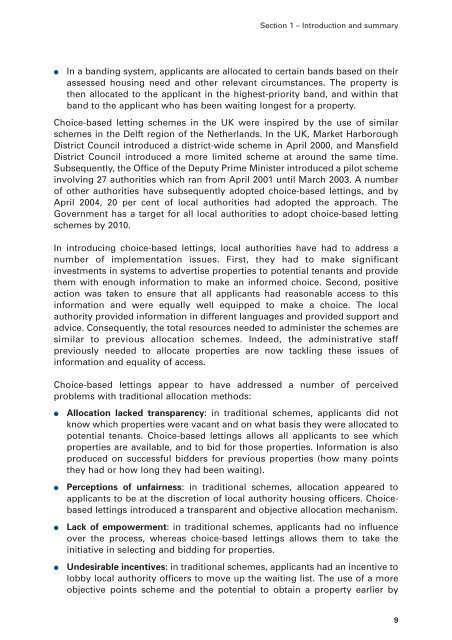Public Policy: Using Market-Based Approaches - Department for ...
Public Policy: Using Market-Based Approaches - Department for ...
Public Policy: Using Market-Based Approaches - Department for ...
You also want an ePaper? Increase the reach of your titles
YUMPU automatically turns print PDFs into web optimized ePapers that Google loves.
Section 1 – Introduction and summary<br />
● In a banding system, applicants are allocated to certain bands based on their<br />
assessed housing need and other relevant circumstances. The property is<br />
then allocated to the applicant in the highest-priority band, and within that<br />
band to the applicant who has been waiting longest <strong>for</strong> a property.<br />
Choice-based letting schemes in the UK were inspired by the use of similar<br />
schemes in the Delft region of the Netherlands. In the UK, <strong>Market</strong> Harborough<br />
District Council introduced a district-wide scheme in April 2000, and Mansfield<br />
District Council introduced a more limited scheme at around the same time.<br />
Subsequently, the Office of the Deputy Prime Minister introduced a pilot scheme<br />
involving 27 authorities which ran from April 2001 until March 2003. A number<br />
of other authorities have subsequently adopted choice-based lettings, and by<br />
April 2004, 20 per cent of local authorities had adopted the approach. The<br />
Government has a target <strong>for</strong> all local authorities to adopt choice-based letting<br />
schemes by 2010.<br />
In introducing choice-based lettings, local authorities have had to address a<br />
number of implementation issues. First, they had to make significant<br />
investments in systems to advertise properties to potential tenants and provide<br />
them with enough in<strong>for</strong>mation to make an in<strong>for</strong>med choice. Second, positive<br />
action was taken to ensure that all applicants had reasonable access to this<br />
in<strong>for</strong>mation and were equally well equipped to make a choice. The local<br />
authority provided in<strong>for</strong>mation in different languages and provided support and<br />
advice. Consequently, the total resources needed to administer the schemes are<br />
similar to previous allocation schemes. Indeed, the administrative staff<br />
previously needed to allocate properties are now tackling these issues of<br />
in<strong>for</strong>mation and equality of access.<br />
Choice-based lettings appear to have addressed a number of perceived<br />
problems with traditional allocation methods:<br />
● Allocation lacked transparency: in traditional schemes, applicants did not<br />
know which properties were vacant and on what basis they were allocated to<br />
potential tenants. Choice-based lettings allows all applicants to see which<br />
properties are available, and to bid <strong>for</strong> those properties. In<strong>for</strong>mation is also<br />
produced on successful bidders <strong>for</strong> previous properties (how many points<br />
they had or how long they had been waiting).<br />
● Perceptions of unfairness: in traditional schemes, allocation appeared to<br />
applicants to be at the discretion of local authority housing officers. Choicebased<br />
lettings introduced a transparent and objective allocation mechanism.<br />
● Lack of empowerment: in traditional schemes, applicants had no influence<br />
over the process, whereas choice-based lettings allows them to take the<br />
initiative in selecting and bidding <strong>for</strong> properties.<br />
● Undesirable incentives: in traditional schemes, applicants had an incentive to<br />
lobby local authority officers to move up the waiting list. The use of a more<br />
objective points scheme and the potential to obtain a property earlier by<br />
9
















